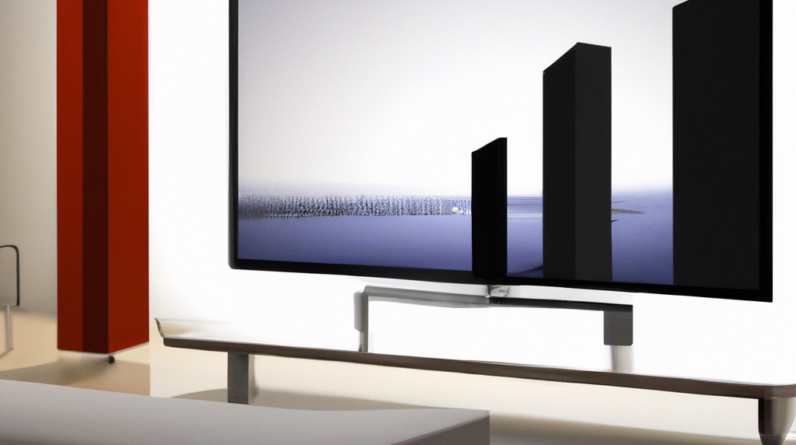
If you’re looking to enhance your media room experience and make it even more immersive, improving the acoustics is key. Whether you’re an avid movie watcher or a passionate gamer, optimizing the sound quality in your space can take your audio experience to the next level. From simple adjustments to adding acoustic panels, this article will guide you through various methods to help you create a sonically captivating environment in your media room.

Understanding Acoustics
Defining acoustics
Acoustics refers to the branch of science that deals with the study of sound and how it behaves in different environments. It involves understanding the way sound is produced, transmitted, and received, as well as how it interacts with various surfaces and objects.
Elements affecting acoustics
Several factors impact the acoustics of a media room. These include the room’s size, shape, and dimensions, as well as the materials used for flooring, walls, and ceilings. Furniture arrangement, speaker placement, and the presence of sound absorption and diffusion techniques also play a crucial role in determining the overall sound quality within the space.
Importance of good acoustics in a media room
Having good acoustics in a media room is crucial for creating an immersive and enjoyable audio experience. Proper acoustic treatment enhances sound clarity, minimizes echoes and unwanted reflections, and ensures accurate reproduction of music, dialogue, and other audio elements. Whether you enjoy watching movies, listening to music, or playing video games, optimal acoustics can significantly enhance your overall media consumption.
Identifying Problem Areas
Assessing current acoustics
To improve the acoustics in your media room, it is essential to assess the current state of your room’s sound quality. Take note of any echoes, excessive reverberation, or muffled audio. Identifying these problem areas will help you target specific issues and effectively address them.
Common issues to look out for
Some common acoustic issues to be aware of in media rooms include excessive echo or reverb, uneven sound distribution, unwanted resonance, and excessive background noise. These issues can diminish the overall audio quality and detract from your media-watching experience.
Using sound metering tools
Using sound metering tools can be particularly helpful in identifying acoustic issues. Sound level meters or smartphone apps designed for measuring sound levels can give you an accurate understanding of the noise levels in your media room. Additionally, acoustic measurement software can provide detailed analysis of room acoustics, revealing frequency response, reverb time, and decay characteristics.
Selecting the Right Flooring and Wall Materials
Impact of flooring on acoustics
Flooring materials can significantly impact the acoustics in your media room. Hard surfaces like tile or hardwood flooring tend to reflect sound, creating echoes and unwanted reverberations. On the other hand, materials like carpet or rugs can absorb sound and help reduce echos, resulting in a more pleasant listening environment.
Choosing carpet or rugs
Carpet and rugs are excellent choices for improving acoustics in a media room. They absorb sound waves, preventing excessive reflection and reducing overall reverberation. When selecting carpet or rugs, opt for thicker materials with thicker padding underneath for better sound absorption.
Cork or hardwood flooring options
If you prefer hard flooring options, consider materials like cork or hardwood. These materials have natural acoustic properties that can help minimize sound reflections. Additionally, incorporating underlayment or acoustic padding beneath the flooring can further enhance sound absorption.
Optimal wall materials for sound absorption
Walls are another crucial element to consider when improving acoustics. Materials with sound-absorbing properties, such as acoustic panels or specialized insulation, can help reduce echoes and improve sound clarity. Fabrics with heavy textures or foam-based soundproofing materials are also effective in absorbing sound waves.
Wall paneling and acoustic treatments
Installing wall paneling or acoustic treatments can further enhance the sound quality in your media room. Acoustic panels, made of materials like fabric or foam, can be strategically placed on walls to absorb sound reflections. These panels come in various sizes, shapes, and designs to match your room’s aesthetic while improving acoustics.
Arranging Furniture and Speaker Placement
Determining optimum seating positions
Proper furniture arrangement is essential to optimize the acoustics in your media room. Consider positioning the seating area at the room’s acoustic focal point. This is typically where the sound from the speakers converges, providing the best audio experience. Experiment with different seating positions until you find the optimum spot for sound immersion.
Maximizing speaker performance through proper placement
The placement of your speakers plays a critical role in achieving optimal acoustics. Positioning them correctly can enhance sound clarity and imaging. For stereo setups, the speakers should ideally be placed at an equal distance from the primary listening position, forming an equilateral triangle. In surround sound setups, follow the manufacturer’s guidelines for speaker placement to ensure an immersive audio experience.
Isolating speakers from surfaces
To minimize vibrations and potential interference, it’s important to isolate speakers from surfaces. Using speaker isolation pads or stands can help reduce resonances and optimize sound quality. These accessories prevent the transmission of low-frequency vibrations to surfaces, resulting in cleaner audio reproduction.
Using speaker stands
Speaker stands are an effective solution for achieving proper speaker placement and isolation. They provide a stable and elevated platform for your speakers, improving sound propagation and reducing the impact of room surfaces on sound quality. Adjustable stands allow you to fine-tune the speaker’s height and angle for optimal listening experience.
Optimizing subwoofer placement
Subwoofers are responsible for reproducing low-frequency sounds, and their placement can significantly impact the overall sound quality. Proper subwoofer placement involves considering room resonances and avoiding placement near corners where bass can become boomy. Experiment with different subwoofer positions to find the optimal spot that offers balanced bass response and impact.

Understanding Room Shape and Size
Evaluating the impact of room dimensions on acoustics
The shape and size of a room have a direct impact on its acoustics. Larger rooms tend to have longer reverberation times, while smaller rooms often suffer from excessive sound reflections due to limited space. Understanding how room dimensions affect acoustics can help you make informed decisions when implementing acoustic treatments.
Addressing square and rectangular room challenges
Square and rectangular rooms can introduce numerous acoustical challenges due to parallel surfaces that can cause standing waves and unwanted resonances. To address these challenges, consider utilizing room dividers or bookshelves to break up parallel surfaces, reducing the negative impact on sound quality. Additionally, diffusers and acoustic treatments on walls can help scatter sound reflections and minimize standing waves.
Minimizing parallel surfaces
Minimizing parallel surfaces is crucial for achieving optimal acoustics. When building or modifying a media room, consider incorporating irregular wall shapes or strategically placing furniture and bookshelves to break up parallel surfaces. This can help reduce the occurrence of standing waves and room modes, leading to improved sound clarity.
Utilizing room dividers or bookshelves
Room dividers and bookshelves can serve a dual purpose in a media room by acting as both functional and acoustic elements. Placing dividers or bookshelves strategically can help break up parallel surfaces and diffuse sound reflections. Additionally, they can serve as storage compartments, reducing clutter and improving the overall aesthetics of the room.
Improving Soundproofing
Differentiating soundproofing and acoustic treatments
It’s important to understand the difference between soundproofing and acoustic treatments. Soundproofing aims to prevent sound from entering or leaving the room, while acoustic treatments focus on improving the sound quality within the room. While both are important, in this section, we’ll focus on soundproofing techniques.
Methods for reducing sound transmission
To reduce sound transmission, consider incorporating soundproofing materials and techniques. Double-layer drywall, acoustic insulation, and resilient channels can help minimize the transfer of sound waves through walls. Additionally, sealing gaps and cracks with acoustic caulking or weather-stripping can further improve soundproofing.
Enhancing door and window insulation
Doors and windows are key areas where sound can leak in or out of the media room. Upgrading to solid core or specialized soundproof doors can significantly reduce sound transmission. Installing weather-stripping and soundproof curtains or window inserts can also help improve insulation and prevent sound leakage.
Sealing gaps and cracks
Gaps and cracks in walls, floors, or ceilings can serve as pathways for sound transmission. It’s important to seal these openings using acoustic caulking or sealants to minimize sound leakage. Pay attention to gaps around electrical outlets, baseboards, and windows, as they are common areas where sound can penetrate or escape.

Using Sound Absorption and Diffusion Techniques
Installing acoustic panels
Acoustic panels are an excellent tool for sound absorption. They can be strategically placed on walls or ceilings to absorb sound reflections and reduce echoes. These panels come in various designs and materials, allowing you to choose options that complement your room’s aesthetic while improving acoustics.
Utilizing bass traps
Bass traps are particularly effective in absorbing low-frequency sound waves. Placing bass traps in room corners or near wall-ceiling intersections helps minimize excessive bass buildup and enhances overall sound balance. These traps can be made of foam, fiberglass, or other specialized materials designed to absorb and trap bass frequencies.
Using diffusers to scatter sound reflections
Diffusers are acoustic devices that scatter sound reflections, preventing sound waves from bouncing directly back to the listener at the same angle. This helps create a more immersive and natural sound environment. Diffusers can be placed on walls, ceilings, or even integrated into furniture to scatter sound reflections and improve the overall listening experience.
Creating an ideal balance between absorption and diffusion
Achieving optimal acoustics requires finding the right balance between sound absorption and diffusion. Excessive absorption can result in a “dead” sounding room, while insufficient absorption can cause echoes and unwanted reflections. By combining sound-absorbing materials with diffusers, you can create an ideal balance, ensuring a natural and immersive sound experience.
Considering Ceiling Treatments
Addressing sound reflections from ceilings
Ceilings contribute to the overall acoustics of a room by reflecting sound waves. Addressing sound reflections from ceilings is important to prevent excessive reverberation and echoes. Adding specially designed acoustic treatments to the ceiling can help absorb sound and improve sound clarity.
Installing acoustic ceiling tiles
Acoustic ceiling tiles are a popular option for improving acoustics in media rooms. These tiles are specifically designed to absorb sound and eliminate echoes. Installing acoustic ceiling tiles can be a cost-effective way to enhance the overall sound quality in your media room.
Using stretched fabric systems
Stretched fabric systems are another viable option for improving sound quality in a media room. These systems involve stretching fabric across a frame, which is then mounted on the ceiling. The fabric acts as a sound-transparent surface, allowing sound to pass through and be absorbed by underlying acoustic materials. This solution provides both acoustic improvement and an aesthetically pleasing ceiling design.
Implementing soundproofing materials above the ceiling
To further enhance soundproofing, consider implementing soundproofing materials above the ceiling. Insulating the space between the actual ceiling and the false ceiling or utilizing soundproof drywall can help minimize sound transmission from neighboring rooms or floors above. These additional measures can significantly improve the overall sound isolation within your media room.

Sound Calibration and Equalization
Understanding the role of calibration
Calibration plays a crucial role in achieving accurate and balanced sound reproduction. It involves adjusting the audio system’s settings, such as speaker levels, distance, and crossover frequencies, to optimize sound performance in your media room. Calibration ensures that sound is delivered precisely as intended, providing a more immersive audio experience.
Using room correction software
Room correction software can enhance sound quality by automatically analyzing your room’s acoustics and making adjustments to compensate for any irregularities or resonances. These software solutions measure the room’s response using a microphone and make real-time adjustments to the audio system’s settings, resulting in improved sound reproduction.
Optimizing speaker response
Optimizing speaker response involves fine-tuning the speaker’s characteristics to ensure accurate sound reproduction. This can be achieved by adjusting the speaker’s frequency response and equalizing any frequency imbalances. By optimizing speaker response, you can achieve a more balanced sound image and improved audio fidelity in your media room.
Fine-tuning sound frequencies through equalization
Equalization involves adjusting the relative levels of different frequencies to achieve a desired tonal balance. By utilizing an equalizer, either as a standalone unit or through audio calibration software, you can fine-tune the sound frequencies to suit your preferences and the acoustics of your media room. This allows for more personalized and optimized sound reproduction.
Seeking Professional Help
When to consult an acoustics professional
While many improvements can be made by following the above guidelines, there may be instances where consulting an acoustics professional is necessary. If you’re experiencing complex acoustic issues, have limited expertise in acoustics, or want to achieve the highest level of sound quality, seeking professional help is recommended.
Hiring an acoustician or audio/video integrator
Acousticians or audio/video integrators are professionals who specialize in optimizing the audio and visual experience within a space. They have in-depth knowledge of room acoustics, audio system setup, and calibration techniques. Hiring these professionals can ensure that your media room receives expert attention and that the acoustics are optimized to the highest standards.
Getting a comprehensive acoustic analysis
A comprehensive acoustic analysis involves an in-depth assessment of your room’s acoustics. Through measurements, simulations, and analysis, a professional can identify specific acoustic issues and provide tailored recommendations to address them. An acoustic analysis is particularly useful for identifying hard-to-detect problems and ensuring that all aspects of your media room’s acoustics are taken into consideration.
Implementing expert recommendations
Once you’ve received expert recommendations from an acoustics professional, it’s essential to implement them effectively. This may involve making structural modifications, incorporating specialized acoustic treatments, or fine-tuning your audio system. By following the expert recommendations, you can optimize the acoustics in your media room to achieve the best possible sound quality.







